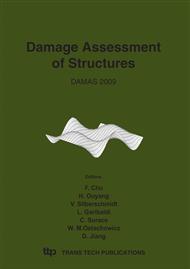p.299
p.305
p.313
p.327
p.335
p.343
p.351
p.359
p.367
Fractal Theory Based Damage Assessing Method of Acoustic Emission Test
Abstract:
Acoustic emission (AE) test monitoring is an effective non-destructive technique. In the paper, a new damage assessing method which is damage acuteness index for AE signal of PZT patches based on fractal theory was proposed. The damage index was deduced by the character of signal analysed by fractal theory. It is deduced that both the curve length and the fractal dimension (FD) of signal are related with damage development. The AE test of Pseudo-static experiment of a concrete-filled GFRP tubes (CFFT) was performed for validation. The results show that the damage acuteness index can assess damage development process effectively. So the damage acuteness index is a promising method to apply in AE test monitoring.
Info:
Periodical:
Pages:
335-342
Citation:
Online since:
June 2009
Authors:
Price:
Сopyright:
© 2009 Trans Tech Publications Ltd. All Rights Reserved
Share:
Citation:


